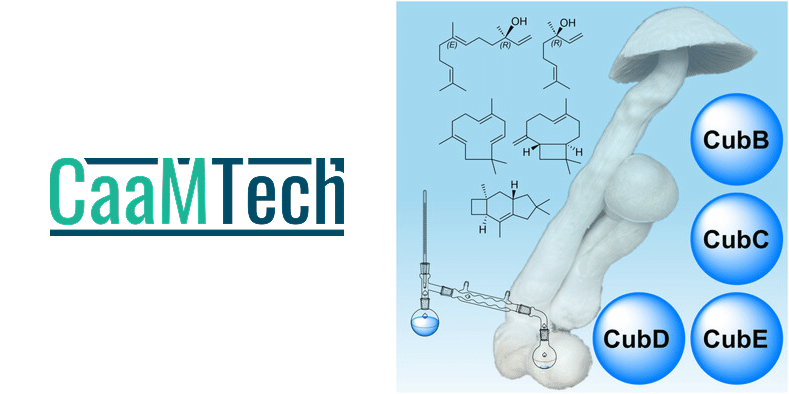
CaaMTech, in collaboration with scientists from Friedrich Schiller University Jena and the Max Planck Institute for Chemical Ecology, has uncovered previously uncharacterized bioactive terpenoids in Psilocybe cubensis “magic” mushrooms. The study, “Clade III Synthases Add Cyclic and Linear Terpenoids to the Psilocybe Metabolome,” was led by researchers in Dr. Dirk Hoffmeister’s lab and published in the journal ChemBioChem.
“If we’re going to study the biological properties of mushrooms or their extracts as drugs, we need to understand everything that’s in them,” said Dr. Andrew Chadeayne, CEO of CaaMTech.
While psilocybin remains the best-known compound in psychedelic mushrooms, it represents just one part of a chemically diverse system. Psilocybe mushrooms also produce tryptamine analogs, beta-carbolines, and—the topic of this recent paper—bioactive terpenoids that may influence the mushrooms’ overall pharmacological effects. Just as caffeine is not coffee, and THC is not cannabis, psilocybin is only one component of a much broader chemical ensemble in magic mushrooms.
Scientists remain divided over the significance of the “entourage effect” – the idea that therapeutic outcomes from consumption of magic mushrooms may depend not just on psilocybin itself, but on its interaction with other naturally occurring compounds present in the mushrooms.
The study focused on four enzymes from Psilocybe cubensis: CubB, CubC, CubD, and CubE (all members of the sesquiterpene synthase family). The research team expressed these enzymes in laboratory systems, including E. coli and Aspergillus niger, and identified their specific products:
– CubB produces nerolidol and linalool, depending on substrate availability.
– CubC synthesizes β-caryophyllene, β-elemene, and α-humulene.
– CubD and CubE, which are structurally similar, both generate sterpurene.
To confirm that these pathways are active in nature, the researchers analyzed P. cubensis tissues directly. They detected nerolidol in fruiting bodies, where CubB is highly expressed, and found β-caryophyllene and sterpurene in the mycelium, consistent with CubC–E activity.
These findings expand the known chemical diversity of psychedelic mushrooms and offer new insight into how multiple compounds may work together to shape therapeutic outcomes. Terpenoids like nerolidol and β-caryophyllene are well studied in other biological contexts and are known for anti-inflammatory, antioxidant, and neuroprotective properties, suggesting they may play a pharmacologically meaningful role alongside psilocybin.
The results support the growing body of evidence for the Entourage Effect – the idea that the combined action of multiple compounds within a natural preparation can enhance or modify its therapeutic profile.
CaaMTech remains at the forefront of efforts to map the complete chemical landscape of psychedelic mushrooms, applying cutting-edge science to understand how these complex organisms work, and why they matter.